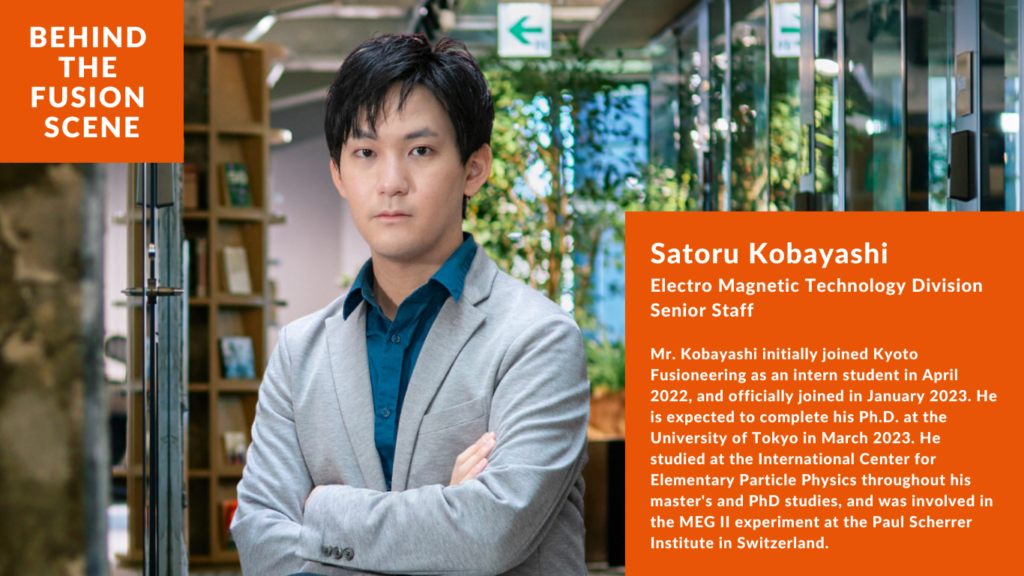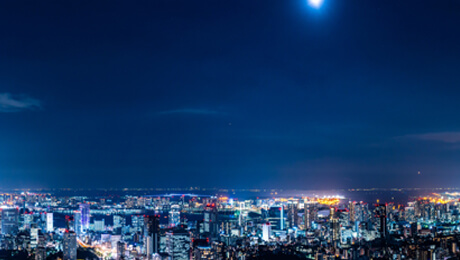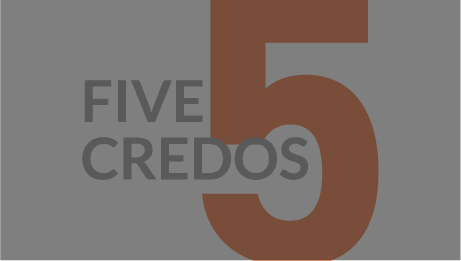
Satoru Kobayashi, Technical Development Department
Mr. Kobayashi initially joined Kyoto Fusioneering as an intern student in April 2022, and officially joined in January 2023. He is expected to complete his Ph.D. at the University of Tokyo in March 2023. He studied at the International Center for Elementary Particle Physics throughout his master’s and PhD studies, and was involved in the MEG II experiment at the Paul Scherrer Institute in Switzerland.
What interested you in particle physics?
When I was a child, my parents took me to the Science Museum and the National Museum of Emerging Science and Innovation, and I developed an interest in science. They hoped that I would discover and feel the excitement of science.
When it came time to choose a career path, I naturally chose the sciences and entered the Department of Physics at the University of Tokyo. In deciding on a field of study, a particle physics experiment particularly caught my attention. In this area, there are many large-scale projects involving many people, and I was attracted to an environment where the team can work together toward one goal. Starting with my master’s degree, I spent six years at the Paul Scherrer Institute in Switzerland, where I participated in a project called the MEG II experiment.
What careers were you considering after your PhD?
When I started my PhD programme, I imagined a career in academia, where I would gain experience and achievements at overseas research institutions and then pursue a stable post in Japan.
However, the COVID-19 has made it more difficult to go abroad than before, and the number of tenured positions in Japan is decreasing, so I began to seek other careers.
In Japan, I often heard about job opportunities for PhD holders in information and AI-related engineering and consultancy, but I thought it would be difficult to aim for a leading position in that area among people who had specialised in computer science and other more relevant fields.
I was interested in space and fusion as two growth industries where I could potentially make use of my experience. Among these, I became more attracted to fusion because I felt there was growth potential in the industry and I thought I could utilise myself more due to its proximity to my field of specialisation.
How did you start your internship at KF?
I discovered Kyoto Fusioneering (KF) while researching fusion companies.
In the autumn of my third year of the PhD programme in Switzerland, I found out that KF was looking for interns on its website. Since it was open to students like myself who were not fusion majors, I immediately applied when I returned to Japan.
I had realised from the experience of my doctoral studies that being able to empathise with the goal of a project is important in achieving my competence and performance, so being able to empathise with KF’s vision and mission urged me to choose KF as a place to work.
In addition, in my search for a place to work, I wanted to choose a job that overlapped three things: what I wanted to do, what I could do, and what was required in the world. I thought that nuclear fusion and working at KF fulfilled all of the above for me.
What projects did you work on during your internship at KF?
I worked on research and development of gyrotrons capable of generating high power electromagnetic waves with high efficiency. In particular, I was involved in the simulation of the electron beam of the gyrotron and the programming work required for this. I had been often engaged in particle simulation in my research and had also dealt with programming, so I was able to make use of my previous experience in both research topics and methods.
In terms of work procedures, since it was a start-up period of R&D, we were expected to think about the next step by ourselves from scratch, rather than proceeding according to set guidelines. I realised that this kind of environment, where I am allowed to proceed with a certain degree of independence, suits me very well.
What did you actually feel when you interned at KF?
I was very grateful to be able to work with and receive guidance from top researchers such as Dr. Sakamoto and Dr. Hirata in the gyrotron field, where Japan leads the world. In addition, being involved in the advancement of research gave me confidence that I could contribute to the team even though I had specialised in a slightly different field.
A gyrotron is a complex device consisting of so many components, including the device that emits the electron beam, the coils used to draw a suitable orbit, and the cavity resonators that extract energy from the electron beam. In the process of understanding its structure by asking questions, I was given comprehensive information on the function of each element, the current status of development and challenges, and I was impressed beyond words to witness the depth of knowledge and experience of the leading experts.
Also, when I applied for the internship, I vaguely imagined an organisation like a group of researchers, but in reality, I could see that not only experienced researchers and engineers, but also experts in various areas, such as management, accounting, public affairs and relations were playing an important role in carrying out projects. I myself have been in an academic environment, but I also feel that the environment at KF where we can work together with non-research professionals allows researchers to concentrate more on their own area of expertise.
How do you see KF changing over the next five years?
The fusion industry itself is developing rapidly, and we need to be able to combine scale and speed to keep up. In addition, I think it will be important to carry out research and development with a big picture, long-term perspective and steadily take steps towards the practical application of fusion.
I believe that KF, which has a team of experts from researchers and engineers to the business side, can achieve these goals.
What would you like to achieve with KF?
I want to make KF a world-leading fusion company.
Personally, I believe that especially my home country Japan, with its limited resources, will necessarily focus on nuclear fusion as a plentiful and accessible source of energy as it considers its energy strategy for the future. At this moment, I’m doing my best to keep up with everyone at KF, but I want to learn from leading professionals like Dr. Sakamoto and his team, so that I strive to be at the forefront of KF.
First of all, I would like to work together with my team on the project I am currently involved in, working towards technological innovations such as further improving the energy efficiency of the gyrotron and increasing its output.
■Visit our recruitment page.
■Previous Behind the Fusion Scene can be found here.




